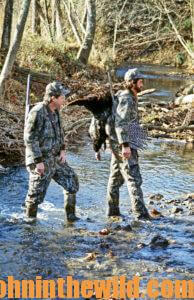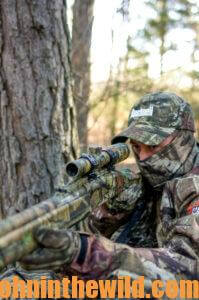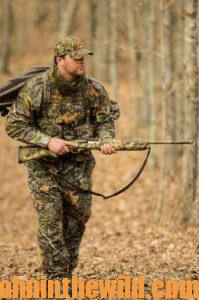Editor’s Note: You can harvest PhD gobblers without using the latest, state-of-the art equipment. However, you don’t have to be miserable to hunt the wild turkey. Using better equipment means you will hunt more comfortably and often more successfully. You’ll also derive more satisfaction from the sport of gobbler chasing. Let’s dress the turkey hunter.
* Caring for Your Feet: The turkey hunter lives or dies on his feet, so proper footwear is critical to a successful hunt. Since the hunter may have to walk, run or wade water, he must have footgear that can get him through, around and over whatever type of terrain he encounters. Start with a pair of polypropylene sock liners to keep your feet warm and dry. If your feet get sweaty in the process of walking to the calling area, polypropylene sock liners will wick the moisture away from your feet and keep them warmer. On top of the sock liner, wear either a cotton or a wool sock, depending on the temperature in which you’re hunting.
 Many sportsmen prefer innersoles inside their boots to cushion the feet against the punishment of long walks, steep climbs and rocky terrain. Keeping the hunter’s feet comfortable is much like having the proper tires on an automobile. If you have the best vehicle in the world, but the tires give way, the vehicle is out of commission. The same is true of the turkey hunter. If his feet aren’t warm, dry and comfortable, he’s headed for a world of misery.
Many sportsmen prefer innersoles inside their boots to cushion the feet against the punishment of long walks, steep climbs and rocky terrain. Keeping the hunter’s feet comfortable is much like having the proper tires on an automobile. If you have the best vehicle in the world, but the tires give way, the vehicle is out of commission. The same is true of the turkey hunter. If his feet aren’t warm, dry and comfortable, he’s headed for a world of misery.
To keep the turkey hunter’s feet warm when he’s pursuing PhD gobblers and give them added support, the hunter needs to wear quality hunting boots. How a boot feels on your foot is often the most-important question when selecting boots. But you’ll also want to look for a top-quality, waterproof pair that is lightweight, yet still provides good arch support. You may want to consider buying a boot with a Vibram, rather than a lug, sole. Vibrams will grip just as well in rough conditions, and you won’t end up “lugging” as much mud around with you. If you’re worried about snakes when hunting turkey, buy a pair of knee-high boots. Any hunter who constantly watches for snakes on the forest floor won’t be able to spot the turkey that may be sneaking toward his spot. Some turkey hunters prefer to wear tennis shoes. Although they may be light and quiet, tennis shoes don’t provide much support, nor do they keep your feet warm or dry. Avoid tennis shoes. Invest in a good pair of boots.
Actually the avid turkey hunter may need two pairs of boots, because rarely will a turkey gobble on the same side of the creek. Most creeks will be over boot-top high. No boot will protect your foot and keep it dry when water pours over the top of it. Bring two pairs: one to wade streams and the other for hiking. The sole of the boot is one area many hunters fail to camouflage. Often, a hunter will sit for long periods of time with his feet stretched straight-out from the tree. If the sportsman has light-colored soles on his boots, those soles will appear like a red light blinking in the night to a PhD gobbler. When a tom comes in, he’ll spot the soles of the boots and be alerted.
* Wearing the Correct Weight of Material and Camo Patterns: Now that we’ve readied the feet, let’s dress the torso, beginning with 100-percent polypropylene or the new high-tech compressing underwear for their ability to wick moisture away from the skin and keep hunters warm. When a hunter is considering which camo pattern is best for him, he must remember that terrain usually dictates the color needed to disguise the hunter. Depending on who you talk to, a strong case can be made for almost every camo pattern. Too, in some instances, the individual bird you’re hunting will help you decide what  camo pattern is best. Some turkeys are experts at dodging hunters. Not only can they distinguish the hunter’s calling, but they seem to have the ability to recognize a hunter’s silhouette when he’s leaning up against a tree. Some old gobblers seem to be able to more easily spot certain types of camo patterns.
camo pattern is best. Some turkeys are experts at dodging hunters. Not only can they distinguish the hunter’s calling, but they seem to have the ability to recognize a hunter’s silhouette when he’s leaning up against a tree. Some old gobblers seem to be able to more easily spot certain types of camo patterns.
One of the best tactics to hide from gobblers is to mix-and-match camo, wearing pants that will blend in with the leafy forest floor and a shirt to make your torso vanish into the tree’s bark. If you’re hunting in a pine forest, a vertical pattern may be the best camouflage. Even when a tree is blown-down, a vertical pattern is best and not out of place in a pine forest. However, if you’re hunting a forest with mixed-age timber, there often will be bushes and shrubs growing on the forest floor below the timber. So, a leaf or a green pattern may be best. Never appear as a solid color against a mixed-color background. Breaking up your silhouette is one of the critical keys to good camouflage. Some hunters drape a Camo Material.
Shirts and pants for the turkey hunter come in all types of material and thicknesses. Some people believe that wearing thinner garments will help them keep cooler during the spring. However, mosquitoes will penetrate light clothing, even though you’re wearing insect repellent. Also, be sure you have a quiet, camouflaged rain suit for turkey hunting in foul weather folded-up in your fanny pack or turkey vest.
* Camouflaging Your Head: There’s a variety of headnets, even with eyeholes for 100-percent peripheral vision that are made with durable netting and  soft, comfortable inner linings and featuring eyeholes for clear, unobstructed vision. Some camouflaged masks feature an open mouthpiece to allow hunters to use diaphragm calls and owl hooters. Don’t put your eyeglasses on under a headnet until you’ve cooled down. A headnet traps heat and will fog glasses. If you must wear glasses while you’re walking to where you want to set-up, purchase some anti-fogging liquid at a camera store. Photographers use this chemical to keep their lens clean and fog free. It works on your eyeglasses. Also use camo paint of makeup on your face.
soft, comfortable inner linings and featuring eyeholes for clear, unobstructed vision. Some camouflaged masks feature an open mouthpiece to allow hunters to use diaphragm calls and owl hooters. Don’t put your eyeglasses on under a headnet until you’ve cooled down. A headnet traps heat and will fog glasses. If you must wear glasses while you’re walking to where you want to set-up, purchase some anti-fogging liquid at a camera store. Photographers use this chemical to keep their lens clean and fog free. It works on your eyeglasses. Also use camo paint of makeup on your face.
* Camouflaging Your Hands: Having the proper gloves is important to the turkey hunter because the hands will move more than any other part of the body when the turkey is at close range. Gloves are available in all types of patterns and material. Cloth gloves are preferred by many hunters because when the mornings are cool, they camouflage your hands and keep them warm. Hunters can stay warm and get a good grip with unlined jersey gloves. Some hunters prefer to wear heavy cotton work gloves in camo patterns with fingers cut out. These gloves are also useful in the winter or fall. Have two or three different types of gloves, not only to match camo patterns but also to match different weather conditions. For instance, in the desert with no mosquitoes, wear net-type gloves. Too, extra-long cotton jersey cuffs cover your wrists for excellent camouflage.
To learn more about turkey hunting, check out John E. Phillips’s book, “PHD Gobblers: How to Hunt the Smartest Turkeys in the World, Revised Edition.” at eBook: https://amzn.to/37BcHJh and Print: https://amzn.to/2O5KNgT.
Tomorrow: Using Other Must-Have Turkey Hunting Products










